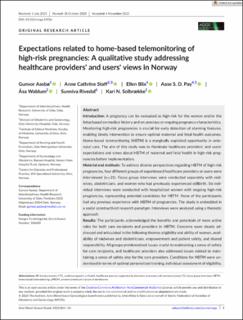| dc.contributor.author | Aasbø, Gunvor | |
| dc.contributor.author | Staff, Anne Cathrine | |
| dc.contributor.author | Blix, Ellen | |
| dc.contributor.author | Pay, Aase Serine Devold | |
| dc.contributor.author | Waldum, Åsa | |
| dc.contributor.author | Rivedal, Sunniva | |
| dc.contributor.author | Solbrække, Kari Nyheim | |
| dc.date.accessioned | 2023-11-24T09:22:46Z | |
| dc.date.available | 2023-11-24T09:22:46Z | |
| dc.date.created | 2023-11-22T08:33:15Z | |
| dc.date.issued | 2023 | |
| dc.identifier.citation | Acta Obstetricia et Gynecologica Scandinavica. 2023, | en_US |
| dc.identifier.issn | 0001-6349 | |
| dc.identifier.uri | https://hdl.handle.net/11250/3104488 | |
| dc.description | This is an open access article under the terms of the Creative Commons Attribution-NonCommercial-NoDerivs License, which permits use and distribution in any medium, provided the original work is properly cited, the use is non-commercial and no modifications or adaptations are made. | en_US |
| dc.description.abstract | Introduction: A pregnancy can be evaluated as high-risk for the woman and/or the fetus based on medical history and on previous or ongoing pregnancy characteristics. Monitoring high-risk pregnancies is crucial for early detection of alarming features, enabling timely intervention to ensure optimal maternal and fetal health outcomes. Home-based telemonitoring (HBTM) is a marginally exploited opportunity in ante-natal care. The aim of this study was to illuminate healthcare providers' and users' expectations and views about HBTM of maternal and fetal health in high-risk preg-nancies before implementation.
Material and methods: To address diverse perspectives regarding HBTM of high-risk pregnancies, four different groups of experienced healthcare providers or users were interviewed (n= 21). Focus group interviews were conducted separately with mid-wives, obstetricians, and women who had previously experienced stillbirth. Six indi-vidual interviews were conducted with hospitalized women with ongoing high-risk pregnancies, representing potential candidates for HBTM. None of the participants had any previous experience with HBTM of pregnancies. The study is embedded in a social constructivist research paradigm. Interviews were analyzed using a thematic approach.
Results: The participants acknowledged the benefits and potentials of more active roles for both care recipients and providers in HBTM. Concerns were clearly ad-dressed and articulated in the following themes: eligibility and ability of women, avail-ability of midwives and obstetricians, empowerment and patient safety, and shared responsibility. All groups problematized issues crucial to maintaining a sense of safety for care recipients, and healthcare providers also addressed issues related to main-taining a sense of safety also for the care providers. Conditions for HBTM were un-derstood in terms of optimal personalized training, individual assessment of eligibility, and empowerment of an active patient role. These conditions were linked to the im-portance of competent and experienced midwives and obstetricians operating the monitoring, as well as the availability and continuity of care provision. Maintenance of safety in HBTM in high-risk pregnancies was crucial, particularly so in situations involving emerging acute health issues.
Conclusions: HBTM requires new, proactive roles among midwives, obstetricians, and monitored women, introducing a fine-tuned balance between personalized and standardized care to provide safe, optimal monitoring of high-risk pregnancies. | en_US |
| dc.language.iso | eng | en_US |
| dc.publisher | John Wiley & Sons | en_US |
| dc.rights | Attribution-NonCommercial-NoDerivatives 4.0 Internasjonal | * |
| dc.rights.uri | http://creativecommons.org/licenses/by-nc-nd/4.0/deed.no | * |
| dc.subject | user perspectives | en_US |
| dc.subject | tele-care | en_US |
| dc.subject | Norway | en_US |
| dc.subject | hospital at home | en_US |
| dc.subject | high-risk pregnancy | en_US |
| dc.subject | focus group interviews | en_US |
| dc.subject | antenatal cardiotocography monitoring | en_US |
| dc.title | Expectations related to home-based telemonitoring of high-risk pregnancies: A qualitative study addressing healthcare providers' and users' views in Norway | en_US |
| dc.type | Peer reviewed | en_US |
| dc.type | Journal article | en_US |
| dc.description.version | publishedVersion | en_US |
| dc.rights.holder | © 2023 The Authors. Acta Obstetricia et Gynecologica Scandinavica published by John Wiley & Sons Ltd on behalf of Nordic Federation of Societies of Obstetrics and Gynecology (NFOG). | en_US |
| dc.source.pagenumber | 1-10 | en_US |
| dc.source.journal | Acta Obstetricia et Gynecologica Scandinavica | en_US |
| dc.identifier.doi | https://doi.org/10.1111/aogs.14726 | |
| dc.identifier.cristin | 2199982 | |
| dc.relation.project | Norges forskningsråd: 326650 | en_US |
| cristin.ispublished | true | |
| cristin.fulltext | original | |
| cristin.qualitycode | 1 | |

